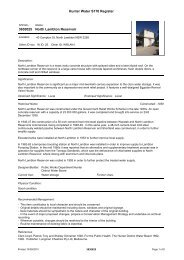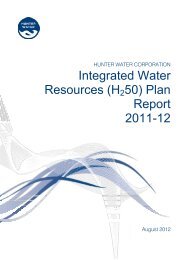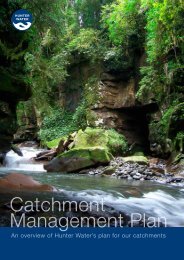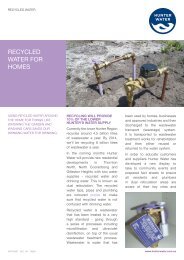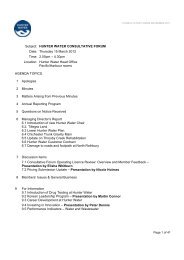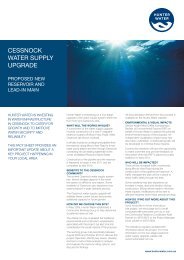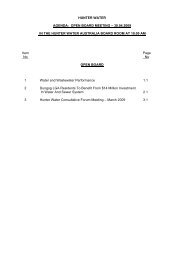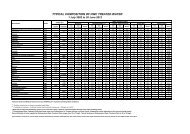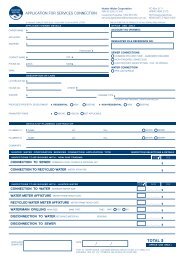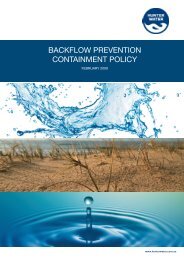Catchment Management Plan - Hunter Water
Catchment Management Plan - Hunter Water
Catchment Management Plan - Hunter Water
You also want an ePaper? Increase the reach of your titles
YUMPU automatically turns print PDFs into web optimized ePapers that Google loves.
3.3.2 The main stakeholders in<strong>Hunter</strong> <strong>Water</strong>’s catchmentsbodyResponsibilitiesIndigenous groups • Custodians of large tracts of Stockton Sandbeds.• As traditional land owners, land and water condition is integral to cultural beliefs.NSW Office of <strong>Water</strong> • The primary regulatory body governing river system health and water sharingbetween resource use and the environment.• Administer <strong>Hunter</strong> <strong>Water</strong>’s licenses to extract raw water• Have limited responsibility to determine the appropriateness of many developmentsor land use practices.DECC • Have a regulatory responsibility to control the discharge of pollutants to watersthroughout drinking water catchments.• Are rolling out a Monitoring, Evaluation and Reporting (MER) program to provideland use and land management data to the public• Regulate the use of chemicals and pesticides• Do not have a planning role for management of diffuse pollution sources in catchments.DECC (NSW NationalParks)<strong>Hunter</strong> – Central RiversCMA• National Parks estate is managed to preserve environmental condition and thereforehelp preserve water quality.• There is significant areas of National Parks in several of <strong>Hunter</strong> <strong>Water</strong>’s catchments• A 10-year <strong>Catchment</strong> Action <strong>Plan</strong> (CAP) has been formulated to improve the healthof 37000km 2 of catchments within the responsibility of the <strong>Hunter</strong> CMA. <strong>Hunter</strong> <strong>Water</strong>’s drinkingwater catchments are a fraction of this, totaling an area of 1450km 2 .• Facilitate grants to individuals and organsations working towards targets in the CAP(such as tree planting, riverbank stabilization).• The CAP is not legislated and, although maintenance of water quality is acornerstone of the <strong>Plan</strong>, it focuses on water for ecological processes above water quality fordrinking purposes.Department of <strong>Plan</strong>ning • Administers the Williams River Regional Environmental <strong>Plan</strong> which was formulated tomanage water quality in the Williams <strong>Catchment</strong>.• <strong>Plan</strong>ning’s Lower <strong>Hunter</strong> Regional Strategy commits to implementing “LEPs thatprotect drinking water catchments, in particular the vulnerable aquifers of Tomago, Tomaree andStockton.”• On ground implementation of these plans is divested to councils.Port Stephens andDungog Shire CouncilsIndustrial landholders(e.g. Tomago Aluminiumand RAAF)• Have significant power to influence the nature of development and therefore runoffwater quality through adherence to applicable acts, regulations and environmental planninginstruments.• Define specific environmental protection zones that are appropriate aroundsource waters.• Have significant powers to influence development, but have had limited guidanceon maintenance of water quality in catchments to date.• Own extensive tracts of land in the catchments• Own tracts of high quality, high environmental value land.• Are bound by conditions of consent and state/federal laws to limit pollution. Havethe capacity to significantly influence quality of land under ownership.<strong>Hunter</strong> <strong>Water</strong> • Manage the <strong>Hunter</strong> <strong>Water</strong> (Special Areas) Regulation which aims to maintaindrinking water quality in catchments.• Own and maintain significant tracts of land in catchments.• Have committed to implementing the Australian Drinking <strong>Water</strong> Guidelines whichput a large emphasis on the protection of source waters.Table 3: Major stakeholders in managing drinking water quality in the catchmentsCATCHMENT MANAGEMENT PLAN . ssS . 001 . JUNE201032




